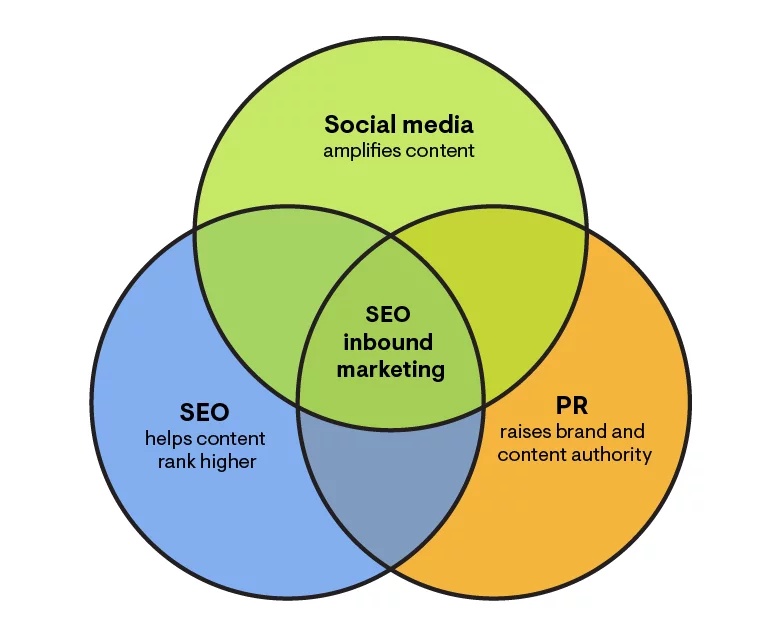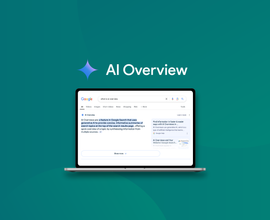The Complete SEO Inbound Marketing Guide
Inbound SEO is the process of optimizing your marketing content to rank higher in search results so your audience can find and engage with your content easily.
How do inbound marketing and inbound SEO work together? Think of inbound SEO as an additional strategy to attract prospects that helps power and improve your overall inbound marketing engine.
8 strategies to develop a winning inbound SEO strategy:
- Define your target audience
- Map channels and content types to the right funnel stages
- Involve the right team members
- Implement a content audit
- Ensure collaboration + alignment of content, SEO, and demand teams
- Prioritize helpful content creation to fuel all of your channels
- Invest in developing a culture of SEO
- Build an authentic social media presence
If you want to improve your marketing performance, you may not need to add headcount or invest more in media. Instead, the most effective strategy might be prioritizing inbound SEO efforts.
A 2021 Gartner survey showed that B2B buyers are 147% more likely to buy when they experience a self-reflective learning path. This type of B2B buying journey includes a combination of digital and human-led channels.
Nearly all self-reflective learning paths include online research, which is where SEO plays a large role from an organic visibility perspective. A 2020 Sistrix analysis of 80 million keywords showed that the first organic search result in Google has an average click-through rate of 28.5% . In fact, the top three organic search results comprise more than half (55.2%) of all organic search click-throughs . Translation: if your content isn’t optimized and ranking at the top of Page 1, you are losing out on significant traffic that your competitors are likely benefitting from.
Higher search engine results page (SERP) rankingsRankings
Rankings in SEO refers to a website’s position in the search engine results page.
Learn more are the result of a well-crafted SEO strategy. That’s why the question for many marketing teams isn’t inbound marketing or inbound SEO. It’s about integrating inbound SEO into your inbound marketing strategy to drive the most impact. Let’s dive deeper into inbound vs. outbound marketing, unpack why SEO is important, and explore eight core foundations of a successful SEO inbound marketing strategy.
What is inbound SEO?
Inbound marketing is a high-level strategy that uses well-crafted and highly targeted content to attract customers by meeting them where they are at each stage of their buying journey. A highly optimized inbound marketing strategy blends content marketingContent Marketing
Content marketing is a marketing discipline with the goal of increasing awareness and scope for products and brands in the desired target group with content published on the web and offline.
Learn more, organic social, and SEO while helping fuel the demand generation funnel.
In contrast, outbound marketing involves reaching out to your audience with content to promote products or services your business offers. It is also referred to as traditional or disruptive marketing. Outbound marketing includes tactics like paid ad campaigns on search engines and social platforms and more traditional marketing methods like direct mail. While outbound marketing is designed to cast a wide net with non-targeted content, inbound marketing focuses on using the right kind of information to attract a specific audience. Inbound is all about showing up and being found organically by your customers where they spend the most time rather than paying to capture their attention.
Inbound SEO is the process of optimizing your marketing content to rank higher in search results so your audience can find and engage with your content easily.
How do inbound marketing and inbound SEO work together? Think of inbound SEO as an additional strategy to attract prospects that helps power and improve your overall inbound marketing engine.
Making the transition to SEO-driven inbound marketing requires the collaboration of multiple teams and departments. You’ll want to align your content marketing, SEO, social media, demand generation, and marketing operations teams on devising an inbound strategy that works across channels and define how success in each channel will be measured. This will ensure full collaboration and buy-in as you develop a strong inbound marketing strategy with a high ROI.
Why is inbound SEO so valuable to a brand’s marketing strategy?
To understand the potential impact of SEO inbound marketing, let’s explore the business benefits of inbound marketing and inbound SEO. Nearly 60% of B2B marketers say that SEO generates more leads than any other marketing initiative.
Inbound leads tend to be less expensive to generate than using traditional paid channels since you aren’t paying per click or impression and content continues to generate leads long after the initial investment has been made. HubSpot data updated in 2017 shows that inbound marketing-dominated organizations experience a 61% lower cost-per-lead than organizations that primarily use outbound marketing.
In addition, SEO helps buyers more easily find and connect with the content they need to solve their problems and make critical purchasing decisions. The average B2B buyer will consume three to five pieces of content before they even talk to a salesperson, according to Demand Gen Report’s 2022 B2B Content Preferences Survey . The more helpful and value-driven you make your content, and the easier you make it for users to find that content on search engines, the more likely you’ll generate sales or high-quality leads.
How to develop a winning SEO inbound marketing strategy: 8 core foundations
Inbound marketing and inbound SEO enjoy a symbiotic relationship. Developing an effective inbound marketing strategy without a comprehensive SEO strategy is difficult. If you're looking to begin an SEO inbound marketing strategy that combines the best of both disciplines, these eight core foundations can help you succeed.
1. Define your target audience
Before you can find the right leads, you need to identify your ideal customer profile (ICP). Once you determine your ICP, you may find it helpful to break your target audiences into more distinct personas. Access additional resources on how to build the right personas for your brand by downloading The Complete SEO Inbound Guide.
2. Map channels and content types to the right funnel stages
Inbound marketing strategies are built around the concept of a funnel, with that funnel (and your audience) getting narrower as you hone in on your buyers’ pain points and your customers get closer to making a decision.
While each company’s marketing funnel may look slightly different, most include these three stages:
- Awareness Stage: This is the top of the funnel. At this stage, your prospects know their pain points and have started doing high-level research to learn how to solve them.
- Education and Consideration Stage: This is the middle of the funnel. At this stage, your prospects understand their problem fully and are looking to identify specific solutions.
- Conversion Stage: This is the bottom of the funnel. At this stage, your prospect knows the type of solution they want to buy. Their only remaining question is which solution to choose.
Download The Complete SEO Inbound Guide to learn more about each stage of the inbound funnel, find out which content types and channels to prioritize for each stage, and get access to the complete visual analysis below for quick tips when content mapping.

3. Involve the right team members
You probably have many of the right people on your existing marketing team to make SEO inbound marketing a success. For optimal results, ensure the following teams are involved in developing, executing, and measuring the success of your inbound SEO strategy.
Content team
Your content marketers should be responsible for creating content that speaks directly to your buyers’ pain points at each funnel stage. Before they begin, they should conduct a thorough content audit, collaborate with the SEO team to identify the most effective keywords and topics for your brand, and map keywords and content to the funnel stages referenced above.
SEO team
It’s a given that your SEO team is responsible for devising and executing against a strategy that optimizes your visibility on SERPs. This involves competitive analysis, content auditing, technical SEO to optimize your site health, and collaborating with your content team to set the direction of new content creation. They should also help you build a culture of SEO across teams, educating colleagues on best practices and evangelizing the importance of SEO organization-wide, so everyone who touches your website operates under the same best practices to maximize your site’s visibility.
Demand generation team
Your demand generation team focuses on generating leads to fuel your marketing and sales funnel. This is where a strong inbound SEO strategy will strengthen the volume and quality of leads. Demand generation tactics may also include creating email nurture campaigns, retargeting, and paid media campaigns that drive conversions like content downloads, newsletter signups, webinar registrations, and free trials.
Social team
Use your social team to amplify your content creation and distribution efforts. Trust them to distribute your most helpful content across the proper channels. Task them with finding influencers and micro-influencers who can help spread the word about your solutions and engage with your target audience across social platforms to build a sense of community around your brand.
Marketing ops
Your marketing operations team is responsible for the implementation and accurate measurement of all your efforts, so you can report on the ROI of your inbound marketing effectively and adapt as needed. Ensure you align on KPIs and a measurement cadence with the stakeholders in your working group in advance.
4. Implement a content audit
One of the struggles many content teams have is spending time churning out new content without understanding the breadth, value, and impact of their existing content. Creating content for the sake of creating content or focusing on creating a high volume of content in a specific time frameFrame
Frames can be laid down in HTML code to create clear structures for a website’s content.
Learn more are rookie mistakes that many new content marketers make.
Access The Complete SEO Inbound Guide for insights on how implementing a content audit can help you generate more effective, intent-driven content.
5. Ensure collaboration and alignment of content, SEO, and demand teams
At Conductor, we’ve optimized team collaboration by implementing the following process. Your content and SEO teams should work together to generate and agree on content topics that will address customer needs and drive organic traffic. Then, these teams collaborate on content briefs with SEOs providing recommendations on elements like keywords, title tags, and meta descriptions. SEOs also provide a final QA check before any piece of content is published on your site.
Your content team collaborates with your demand team to understand the various campaigns demand has planned that will need content support. Content teams provide recommendations on topics that resonate best with different personas at different stages of the funnel to optimize conversions. Your demand gen, social, and content teams will collaborate on content distribution plans. Finally, your marketing operations team, in most cases, is responsible for campaign deployment and reporting.
6. Prioritize helpful content creation to fuel all of your channels
Google’s helpful content update , released in August 2022, aims to have their algorithm prioritize content written for people and reduce the organic visibility of content written solely for search engines to secure SERP rankings. You can meet the intent of the helpful content update by ensuring the content you are creating meets your audience’s needs; simply put, answer the questions your audience is asking.
Leveraging AI-generated content or creating pages on your website to target specific queries without trying to meet the need or intent behind those searches will not provide a shortcut to ranking at the top of page 1 on Google. Prioritizing authentic, helpful content continues to be the focus of Google algorithm updates and the best approach to attracting a loyal following. To supplement your optimized content, develop a strong distribution plan across channels. Here’s how that creates maximum results:

7. Invest in developing a culture of SEO
In an ideal state, creating a culture of SEO means that everyone on your marketing team—and other teams throughout your organization—understands the value that SEO brings to your business and how to incorporate SEO into their initiatives. You can start creating a culture of SEO by teaching your content team best practices to incorporate into every step of the content creation process to drive more, better quality traffic. Three additional SEO culture-building exercises include:
Implementing the PIE methodology
The PIE methodology is a Conductor framework designed to help improve organic visibility on SERPs for topics that matter most to your audience. PIE stands for Protect, Improve, and Expand.
Investing in regular in-depth keyword research
The language your customers use to find your products is constantly changing, and knowing the nuances of their language matters. We recommend teams perform regular keyword research for every new piece of content and each new product offering to ensure it aligns with the voice of your customer.
Expanding SEO knowledge
Creating a culture of SEO means getting your content team and your overall marketing team to care about SEO. Show them that SEO data is buyer intent data. Teach them the foundational elements of technical SEO. Four top areas to focus on include:
Download the full guide to get an in-depth walkthrough of the PIE methodology and how to implement, learn more about keywordKeyword
A keyword is what users write into a search engine when they want to find something specific.
Learn more research strategies, and do a deeper dive into the four technical SEO elements listed above.
8. Build an authentic social media presence
Google data shows that 40% of Gen Z prefers using TikTok and Instagram for search over Google . This speaks to the importance of building an authentic social media presence to extend your inbound marketing efforts and tell your brand story in a way that connects with your target audience. Invest in the channels your audience uses. These will differ for each company, so dig deep and examine whether emerging or non-traditional social channels like Reddit may benefit your business.
A real-life SEO inbound marketing success story
BraunAbility is a top U.S. provider of wheelchair-accessible vehicles. As they scaled up their marketing team, they noticed difficulties with their small WordPress site. They saw the value in inbound marketing and formed a partnership with Conductor to make it happen.
Within eight months, BraunAbility grew website leads by 24%, helping to sell 14% more wheelchair-accessible vans and highlighting the significant revenue generation an effective inbound SEO marketing strategy can produce.
Download our Complete SEO Inbound Marketing Guide for additional insights and exclusive access to the visual funnel mapping the top channels and content types to target for each stage of the funnel for B2B and B2C.







